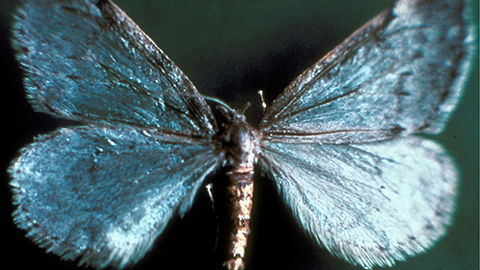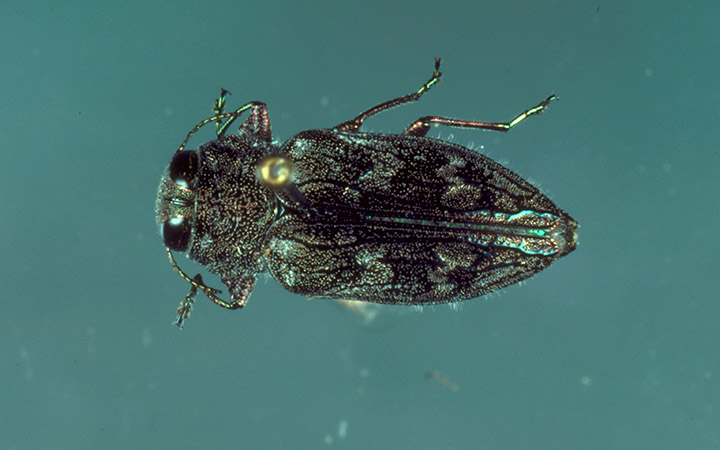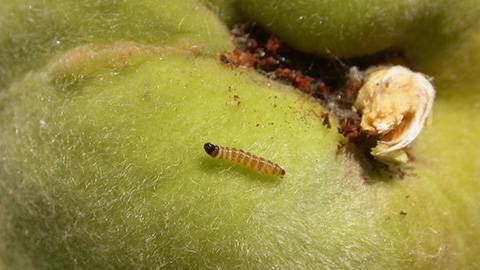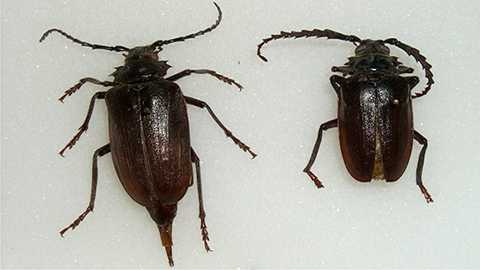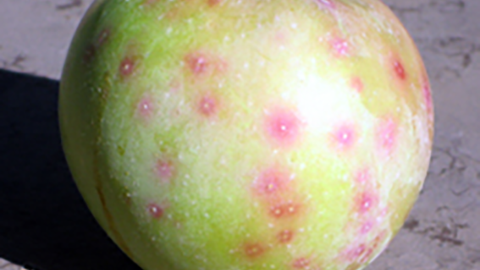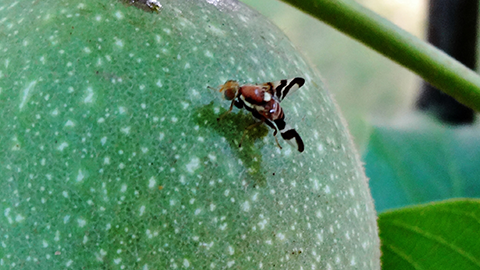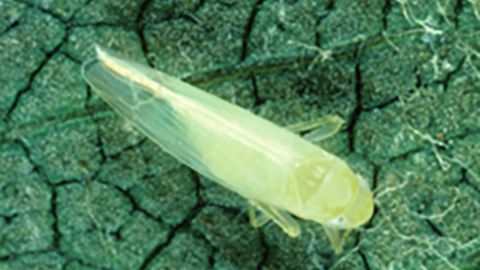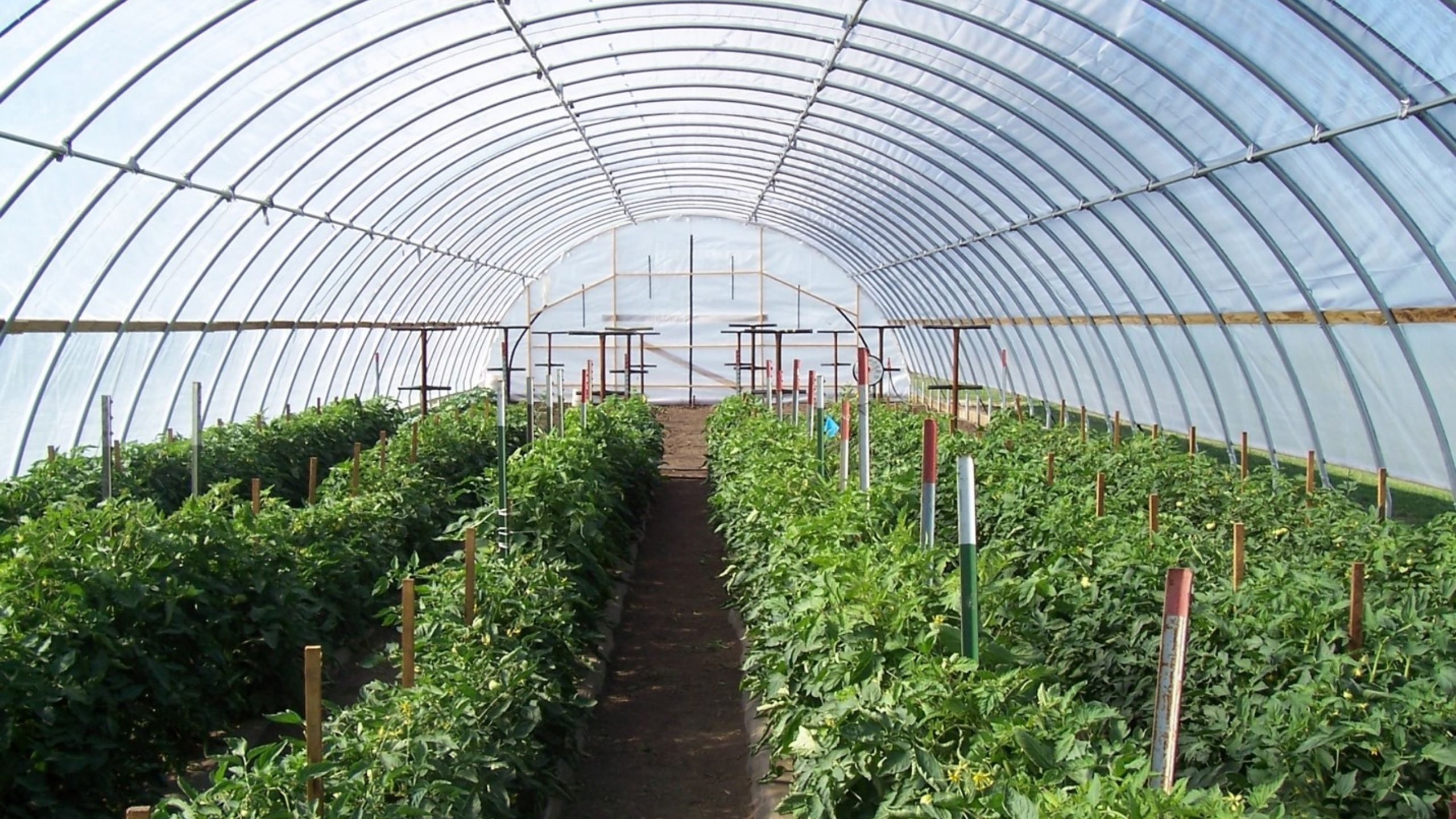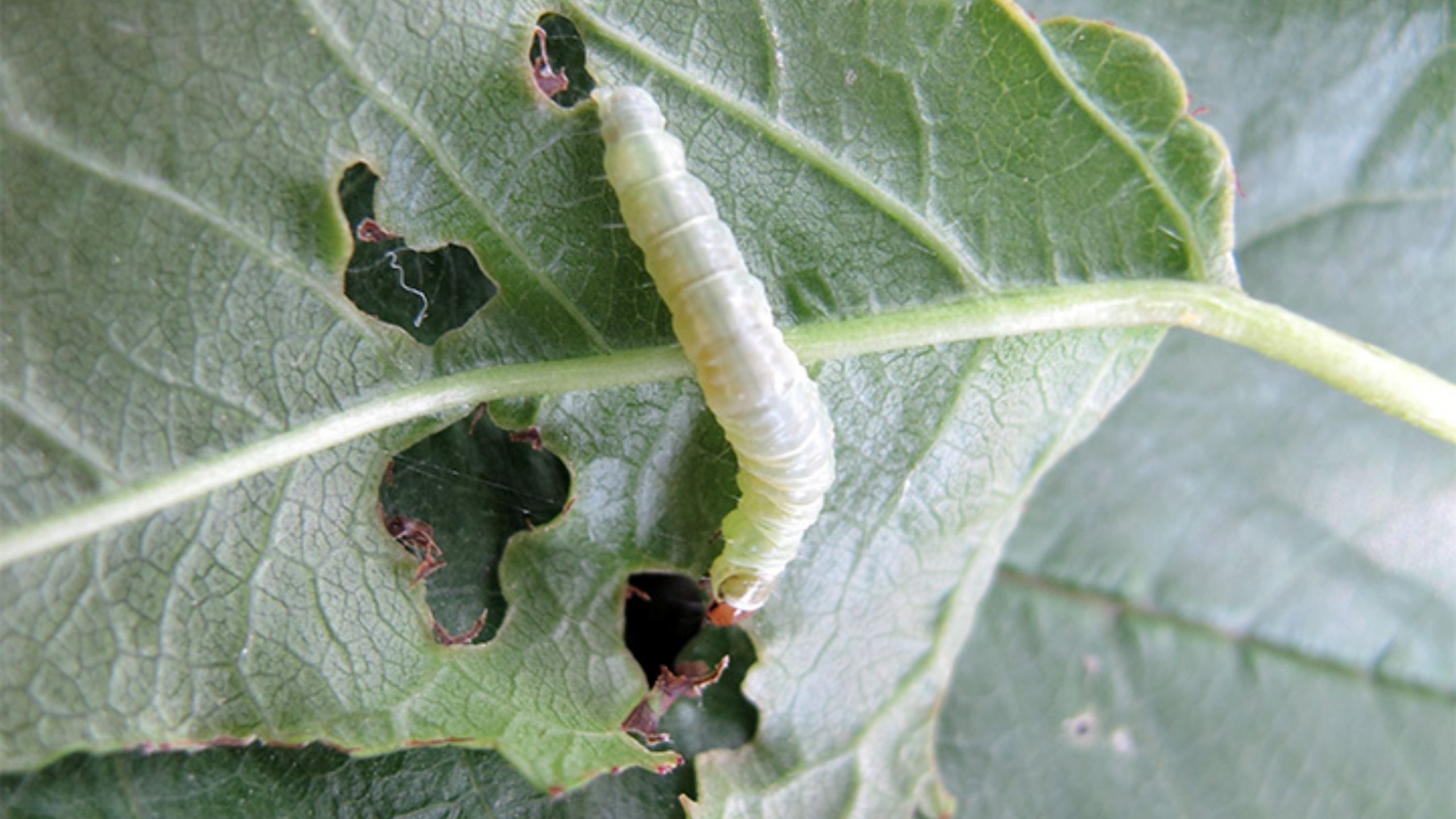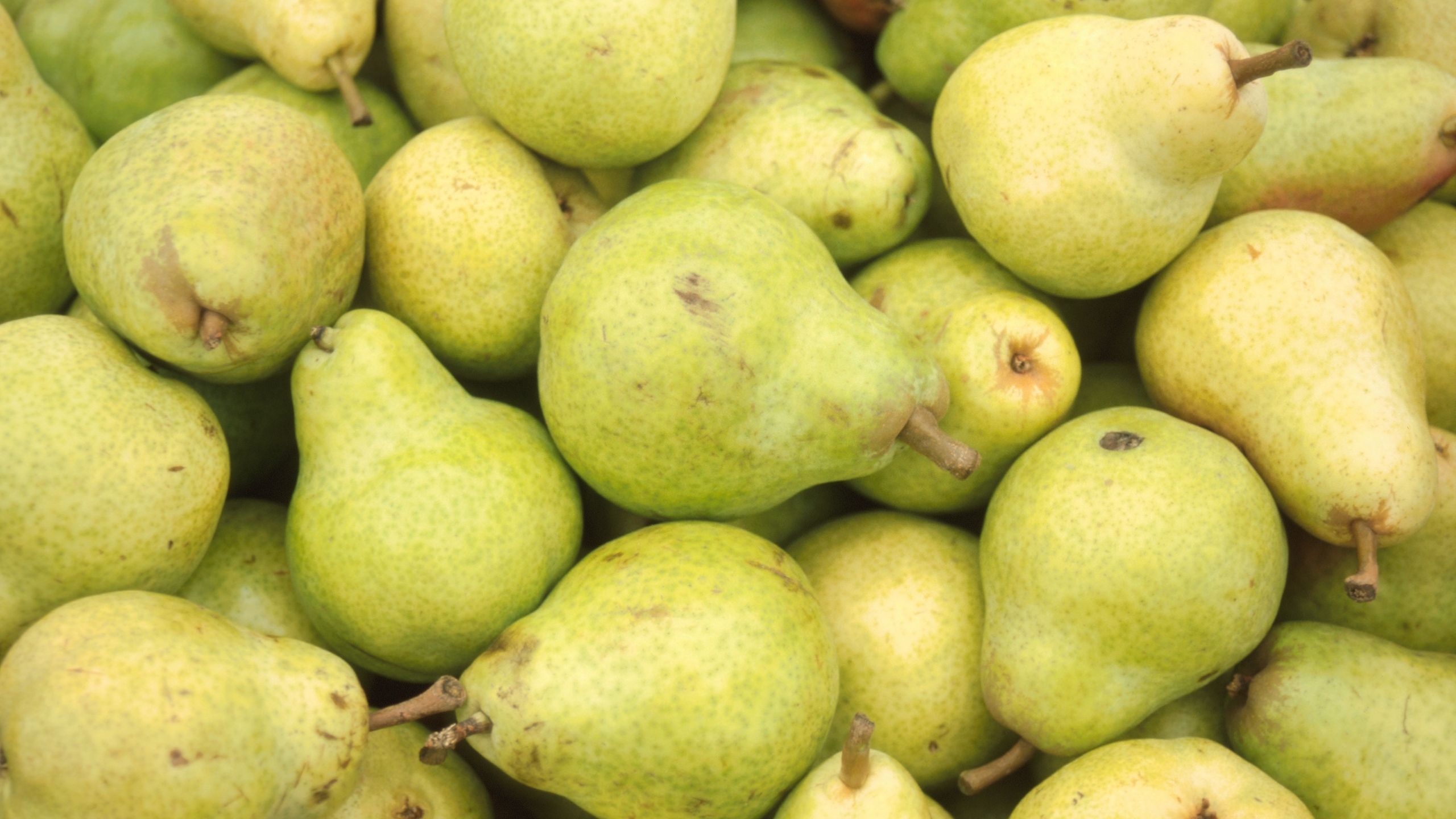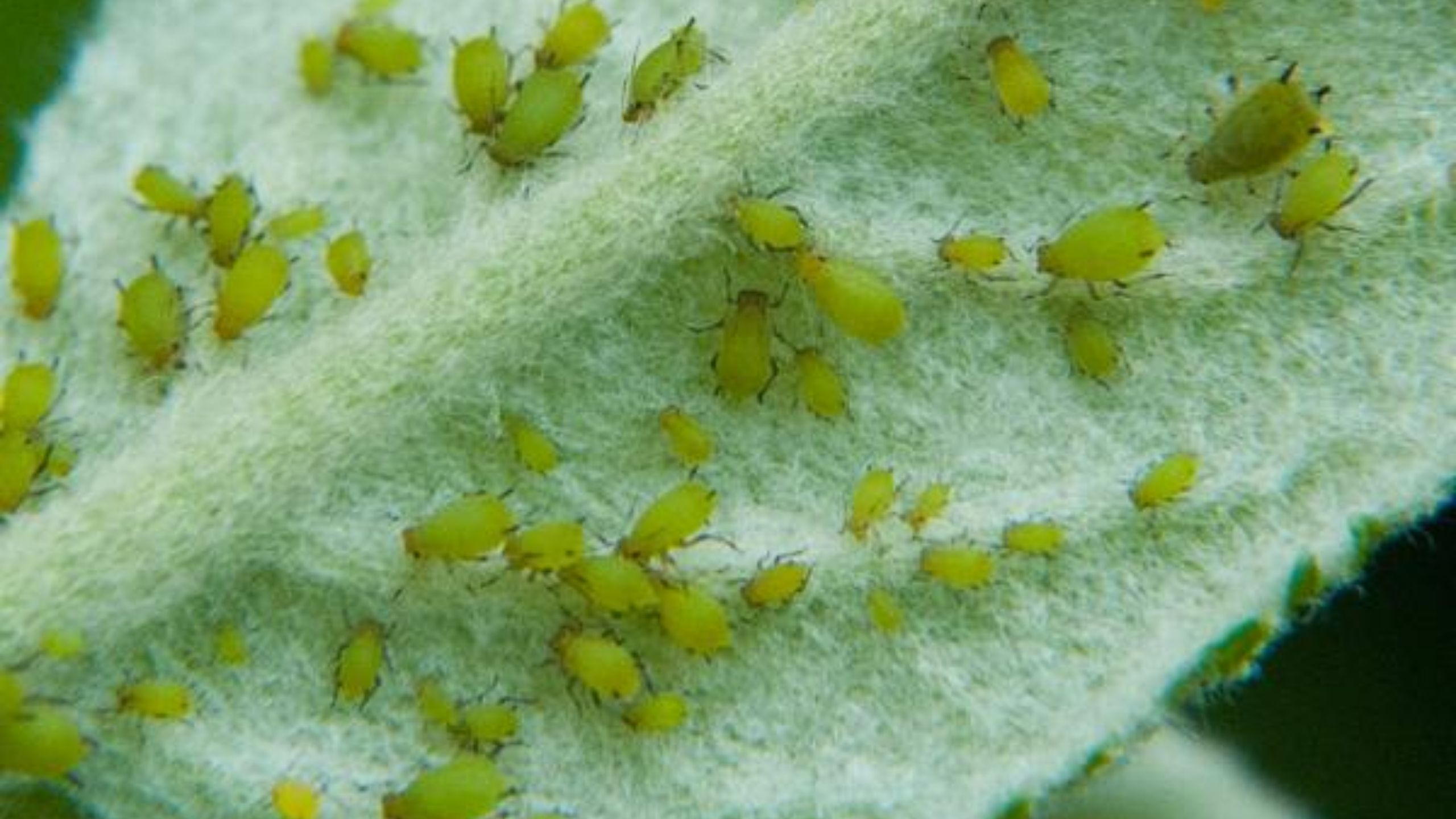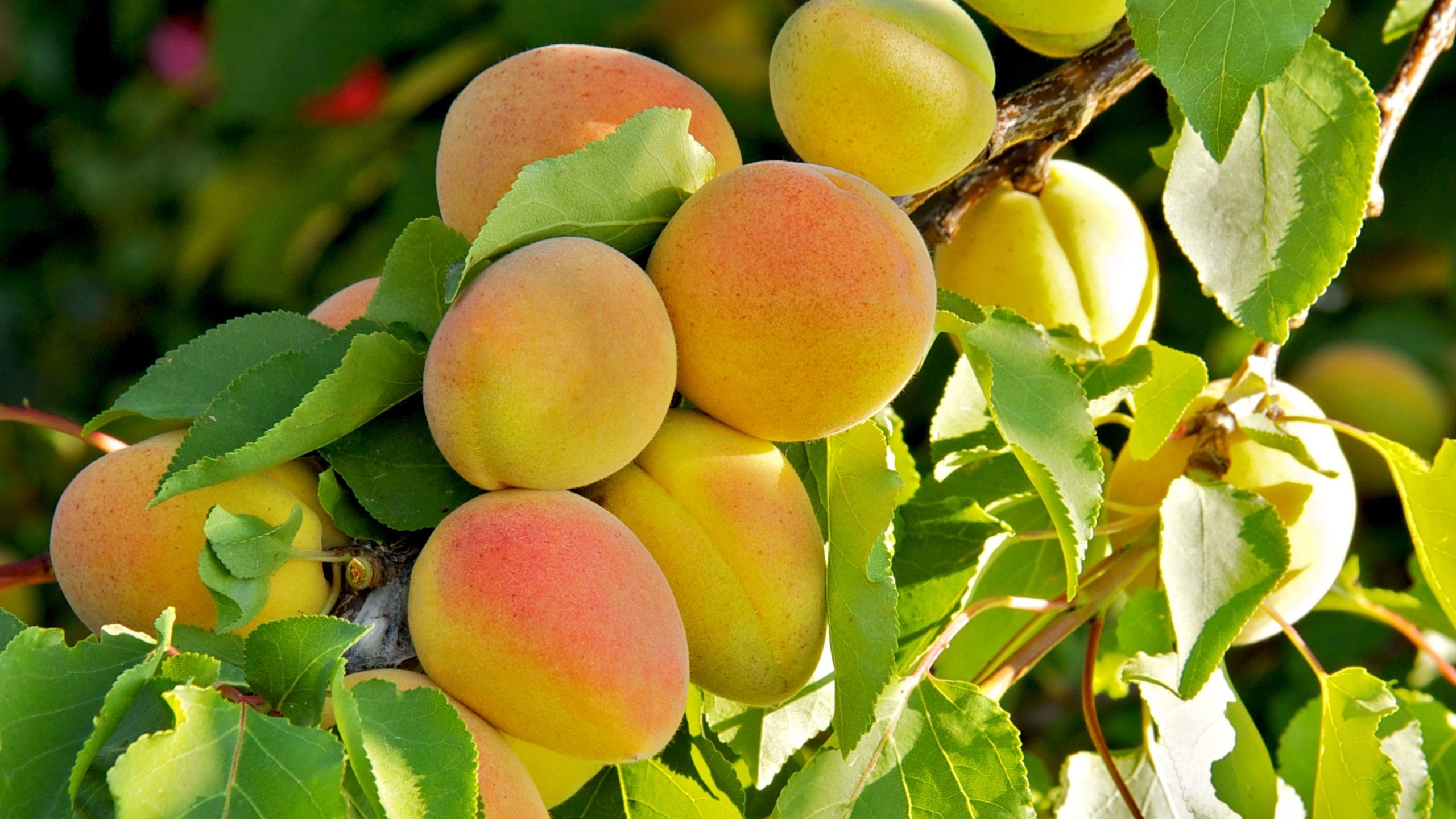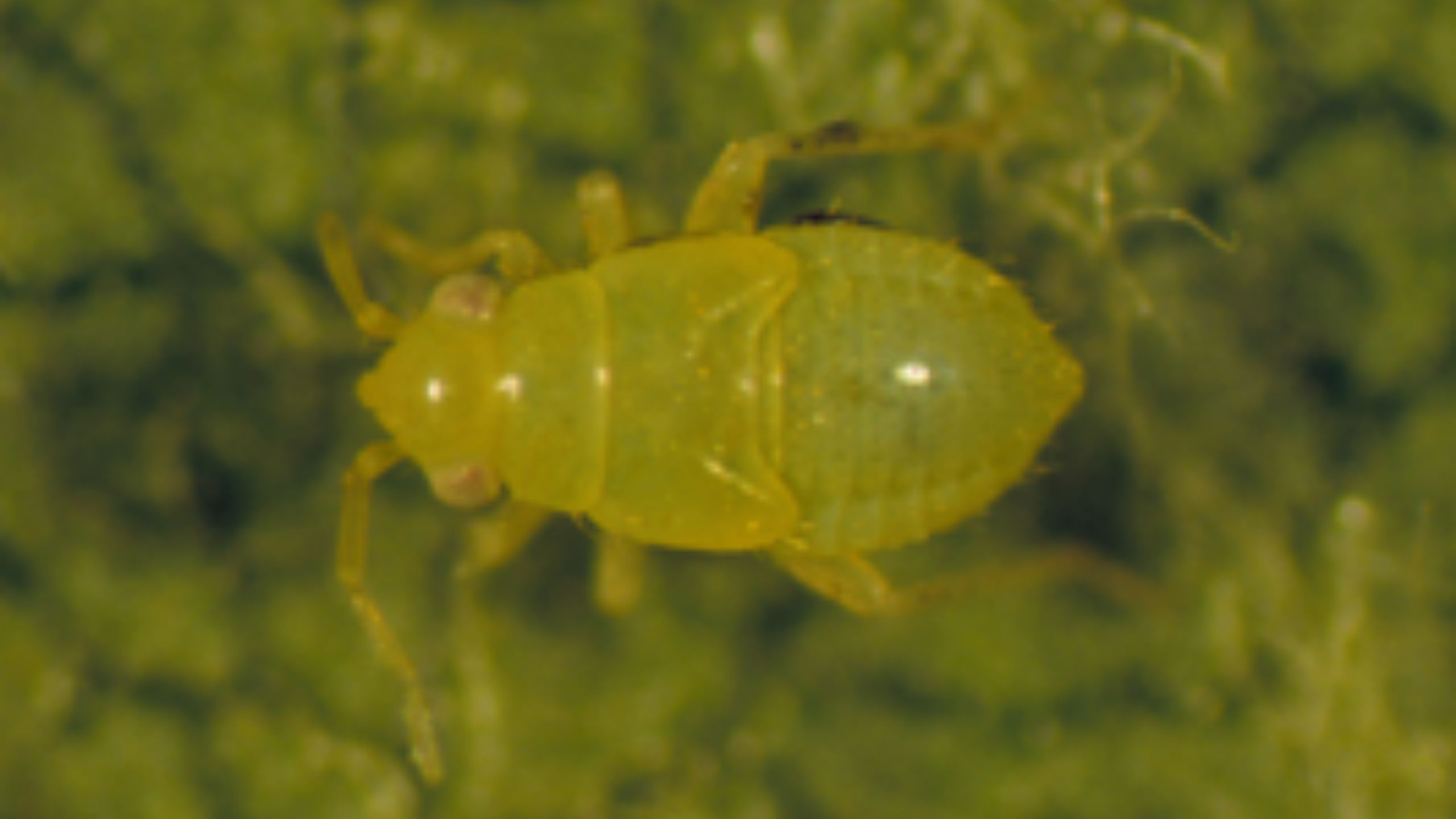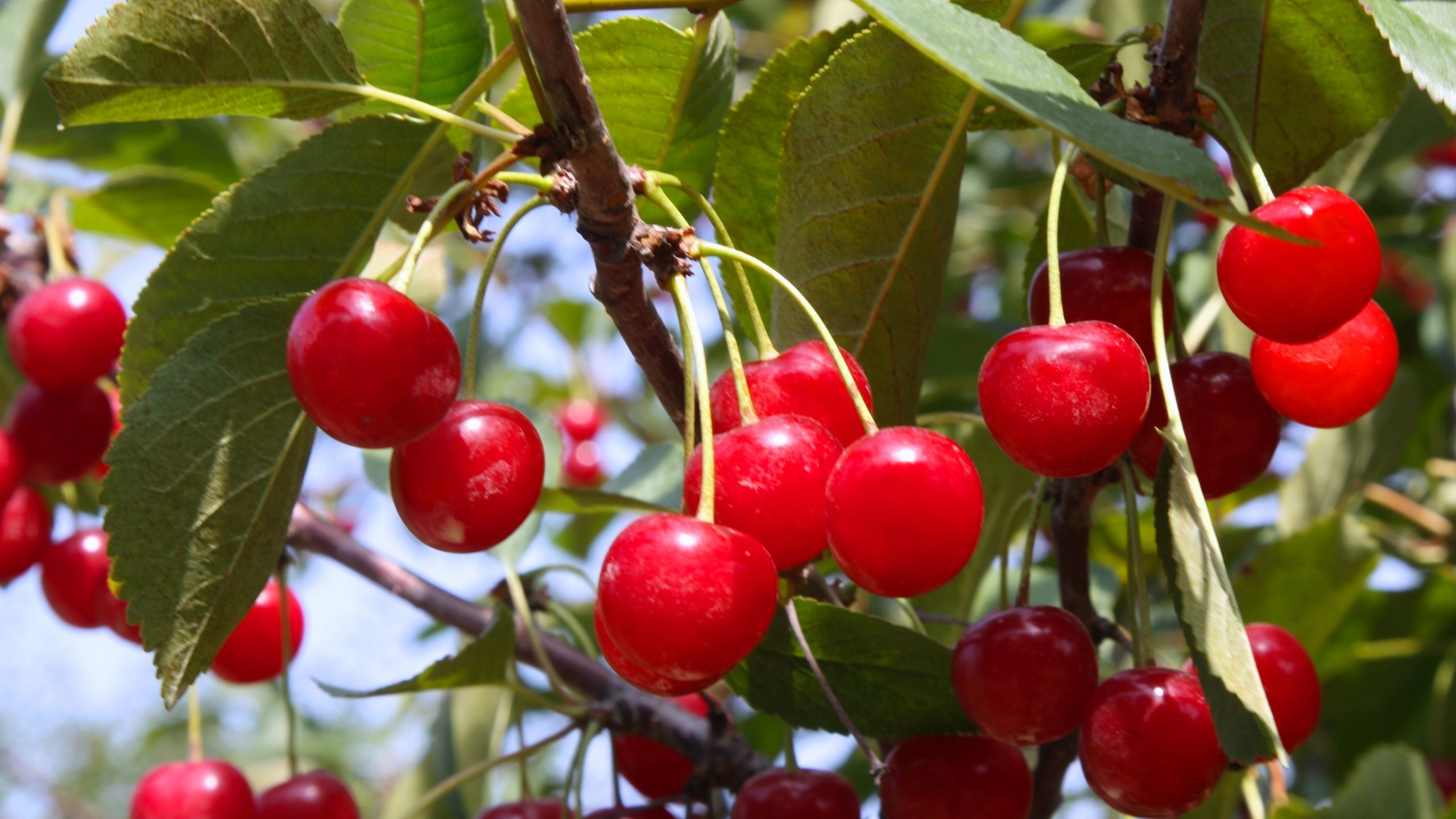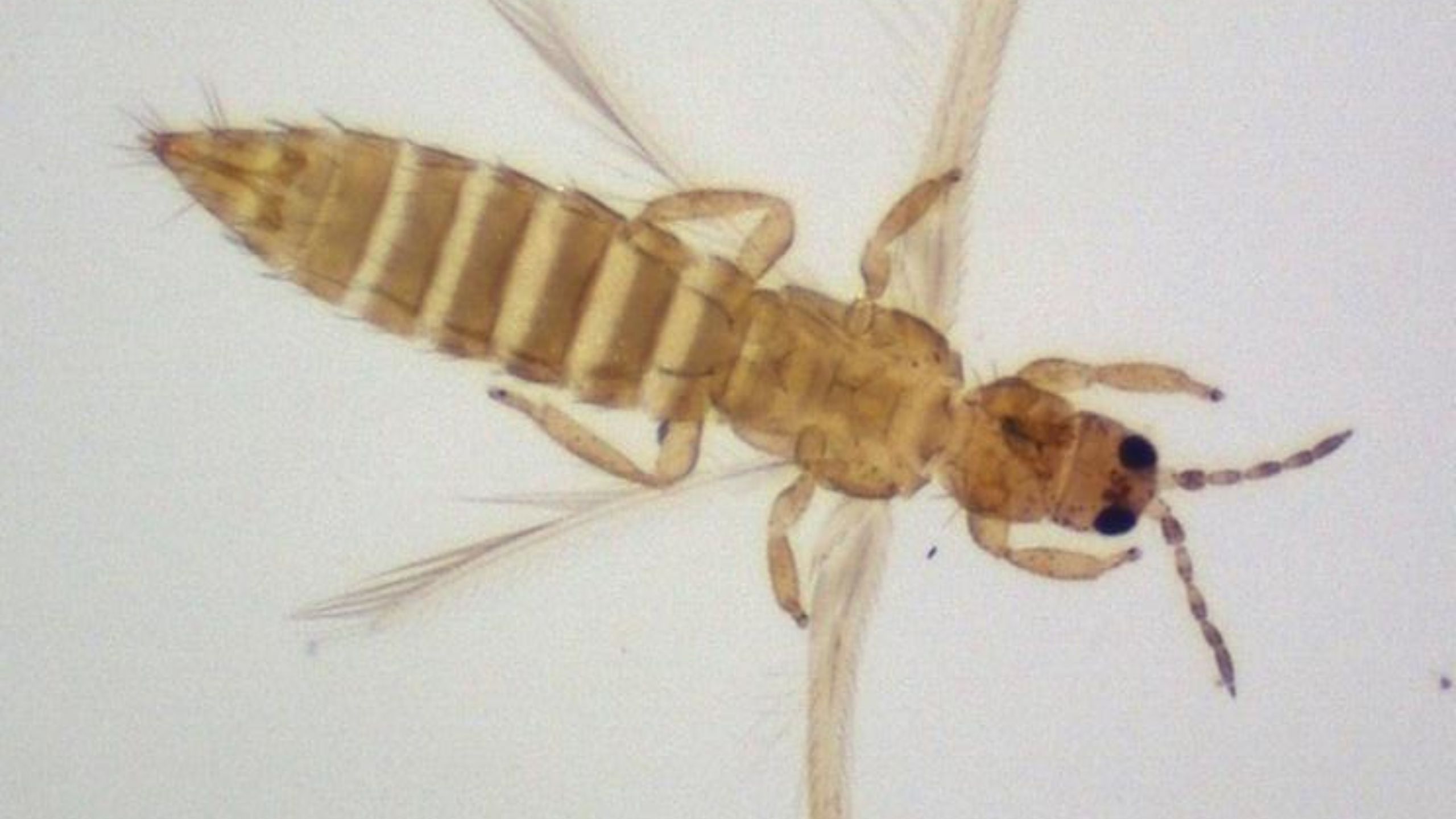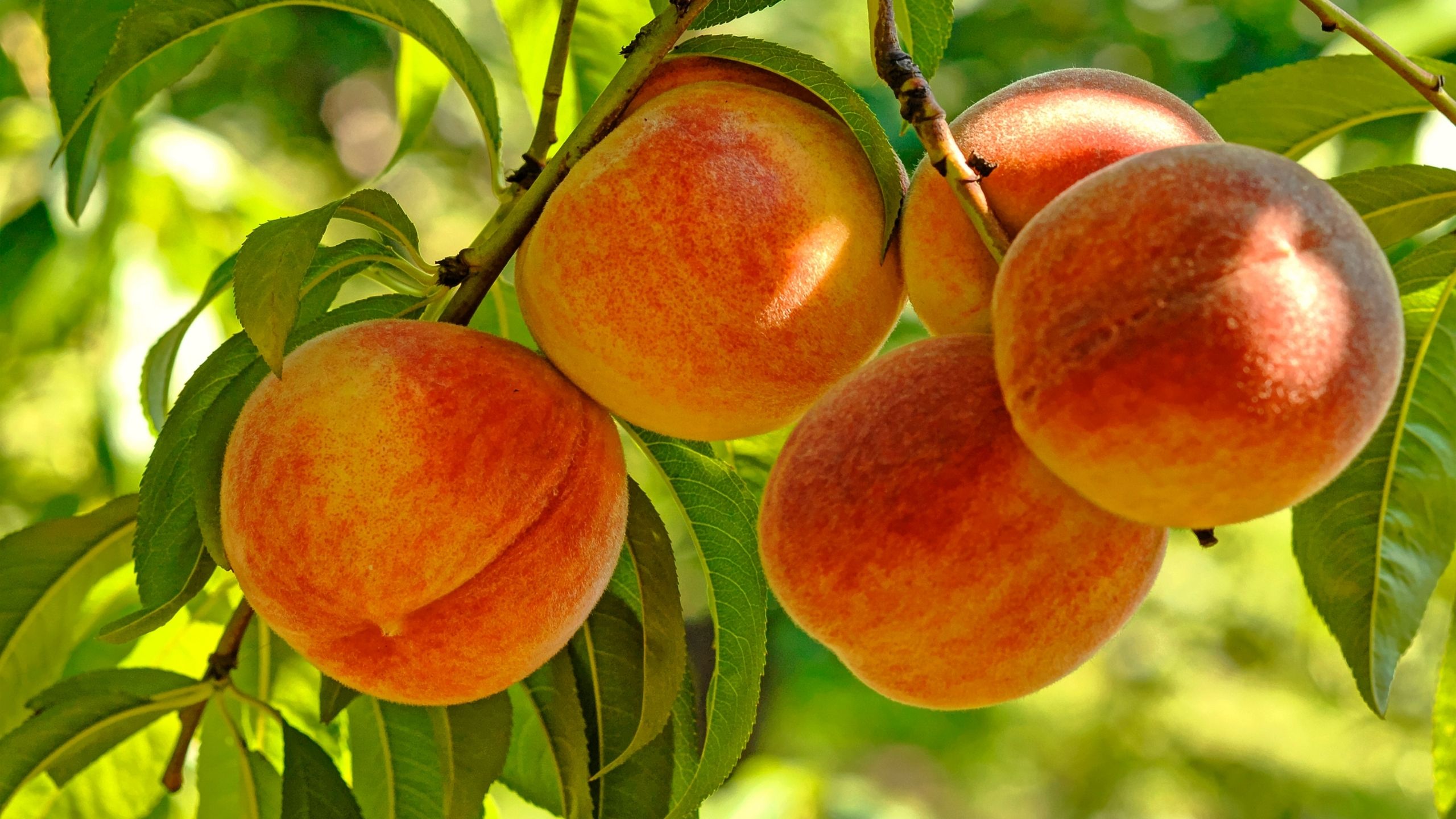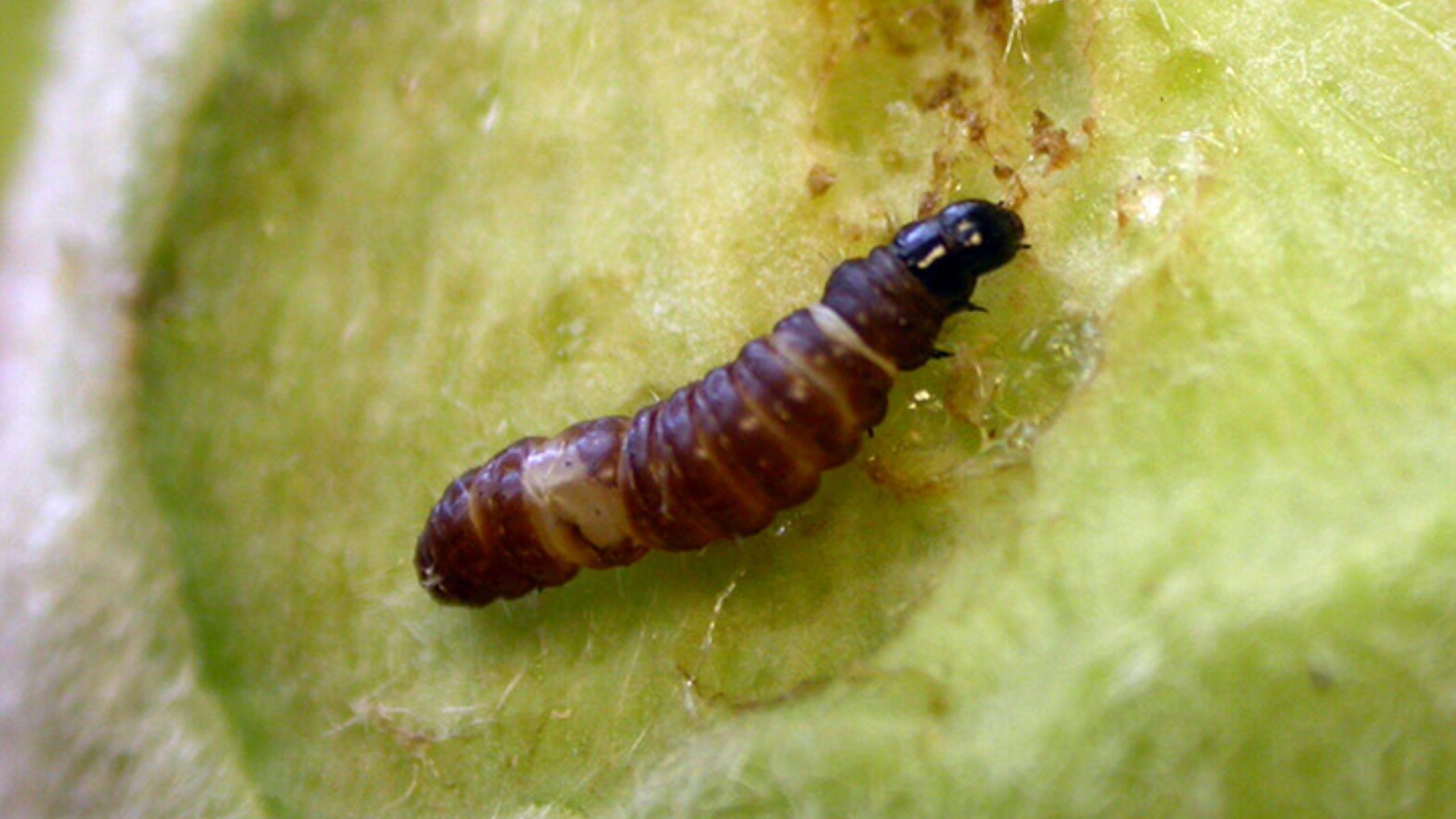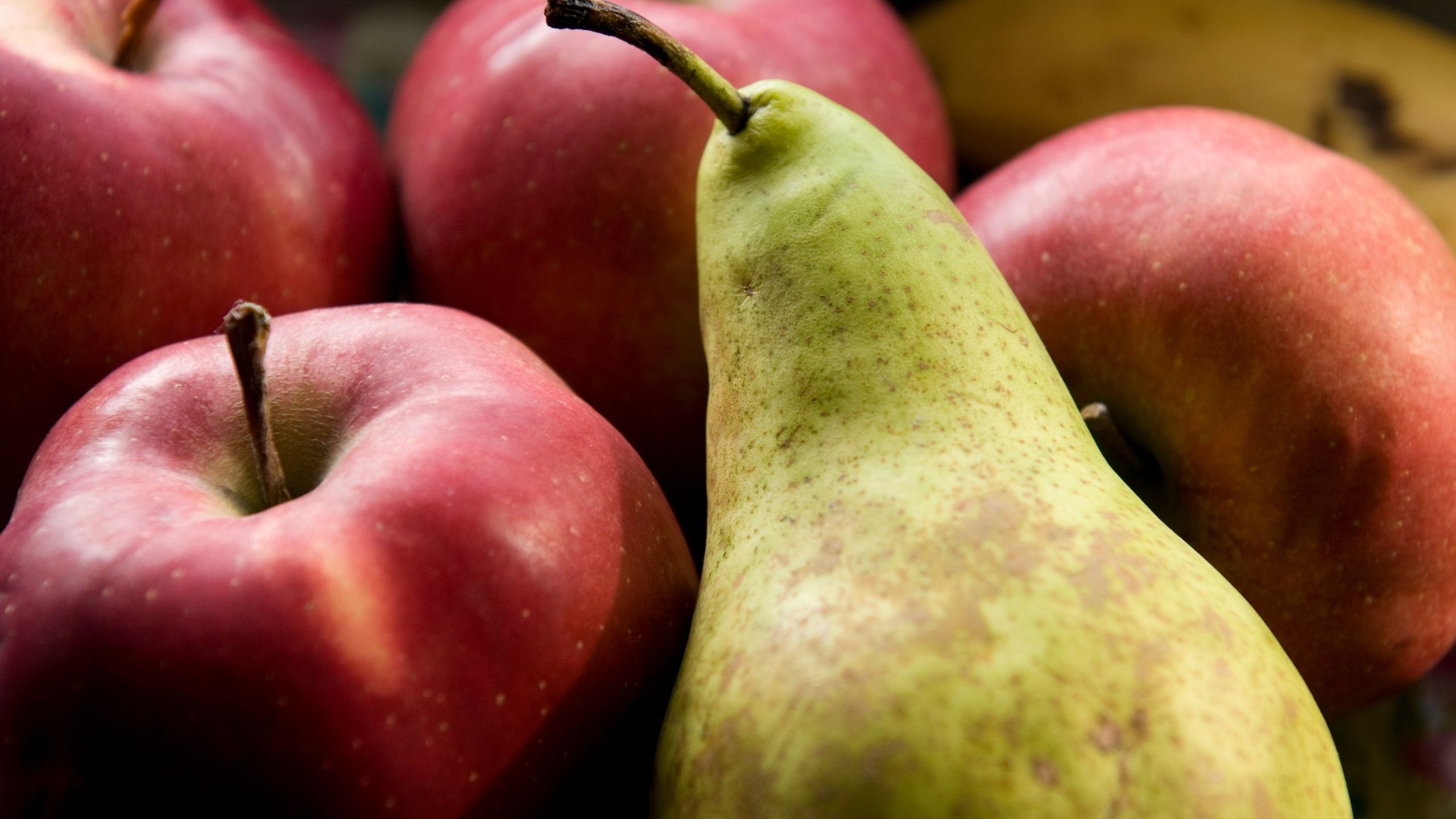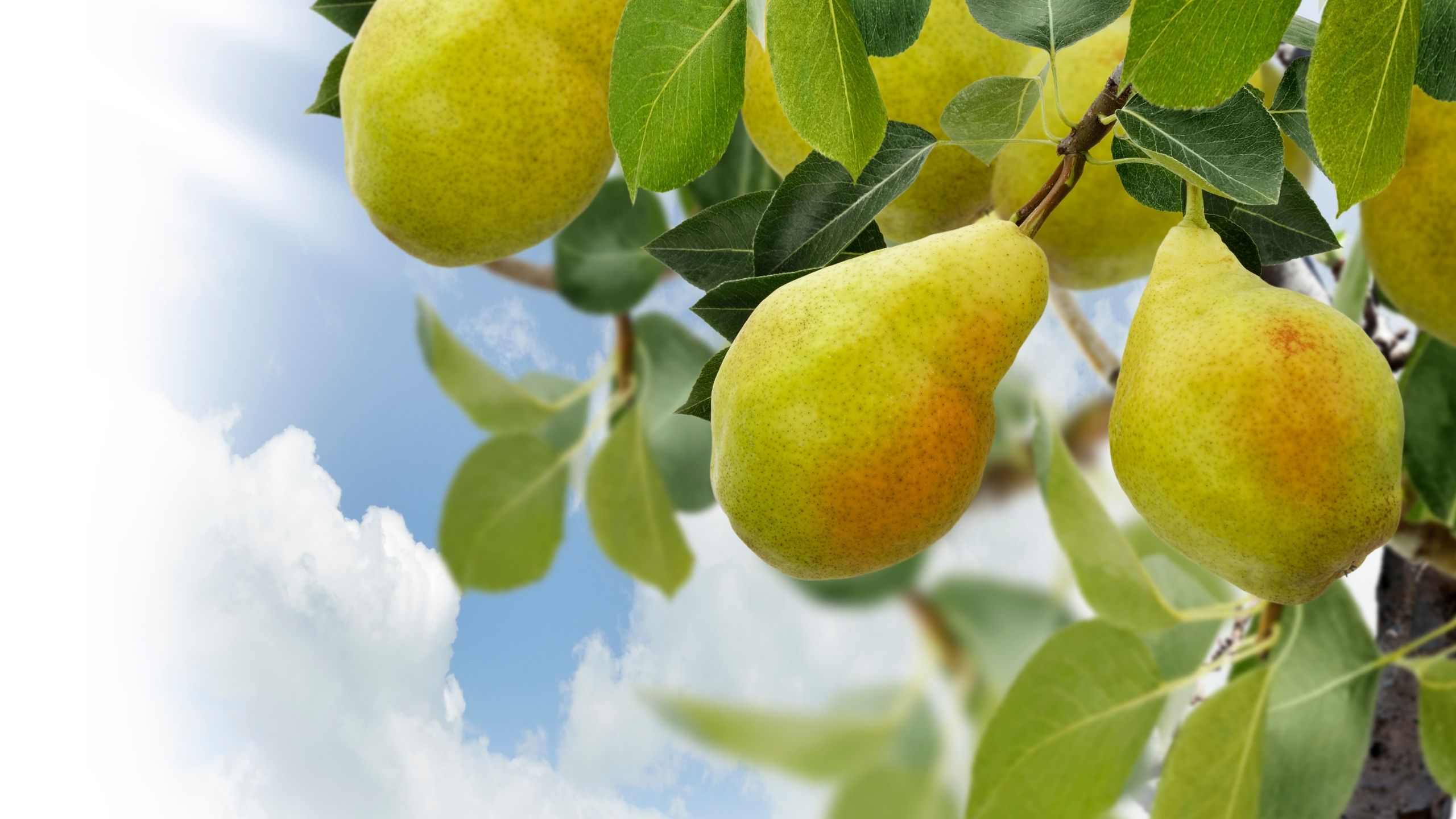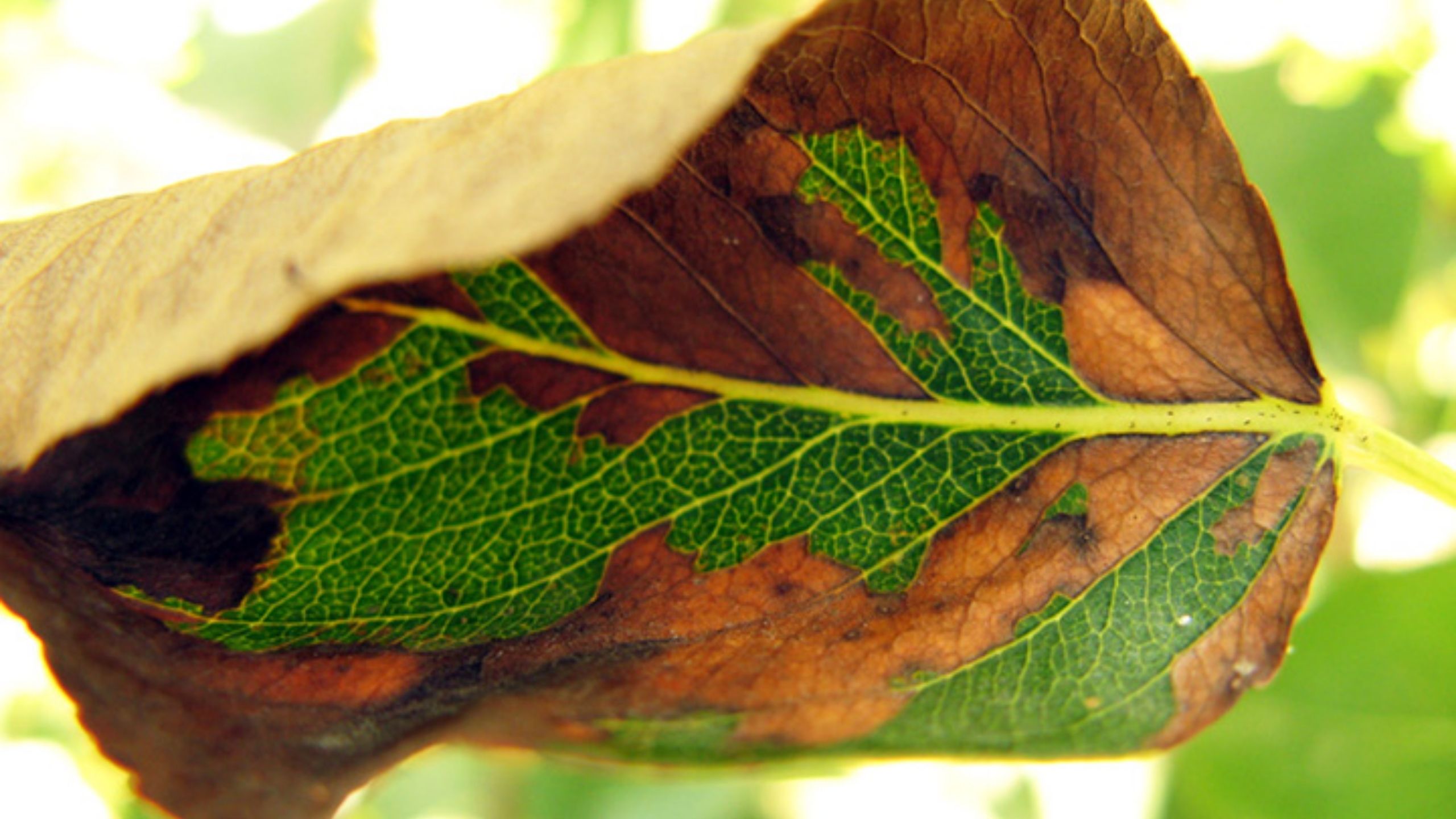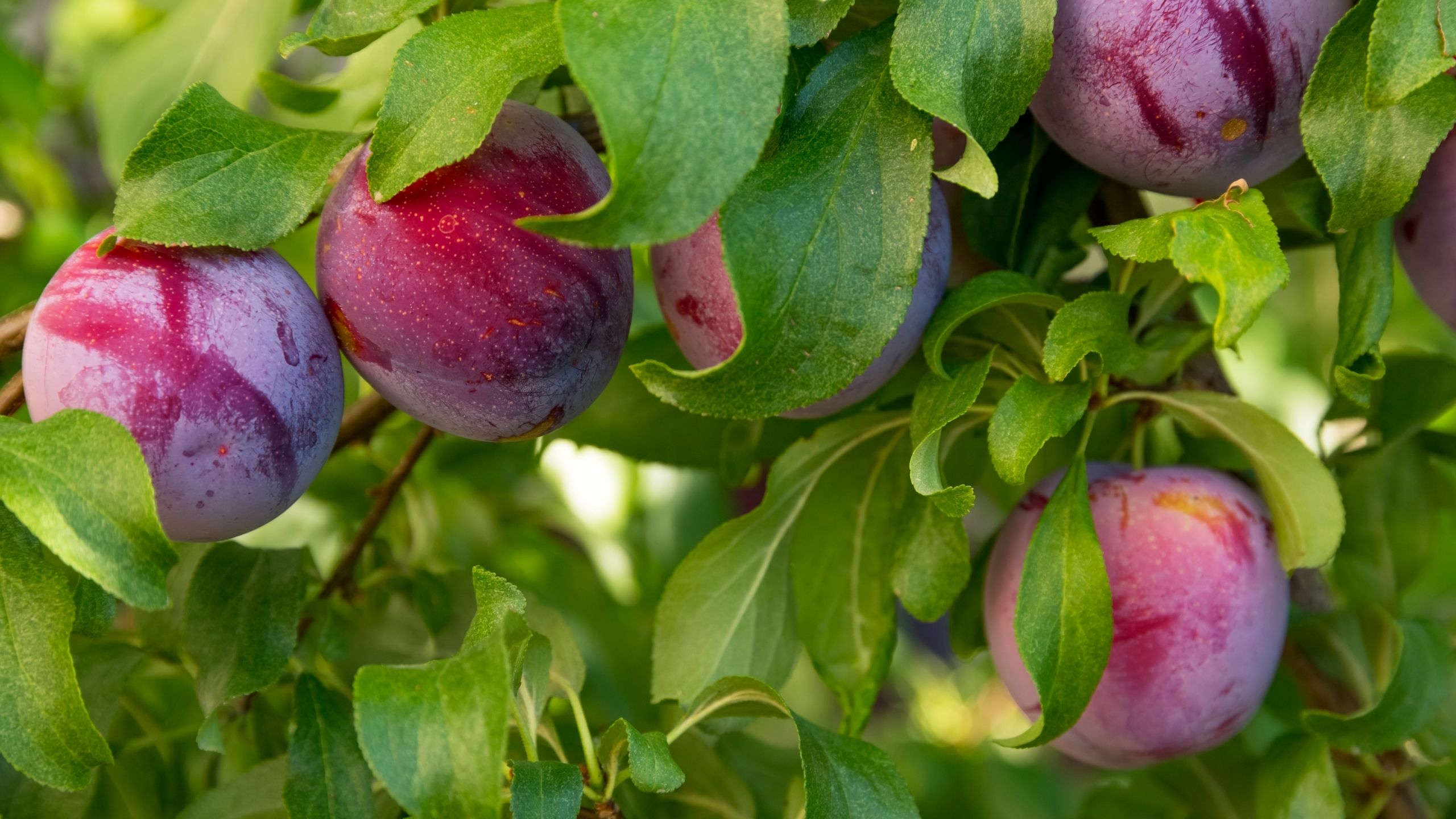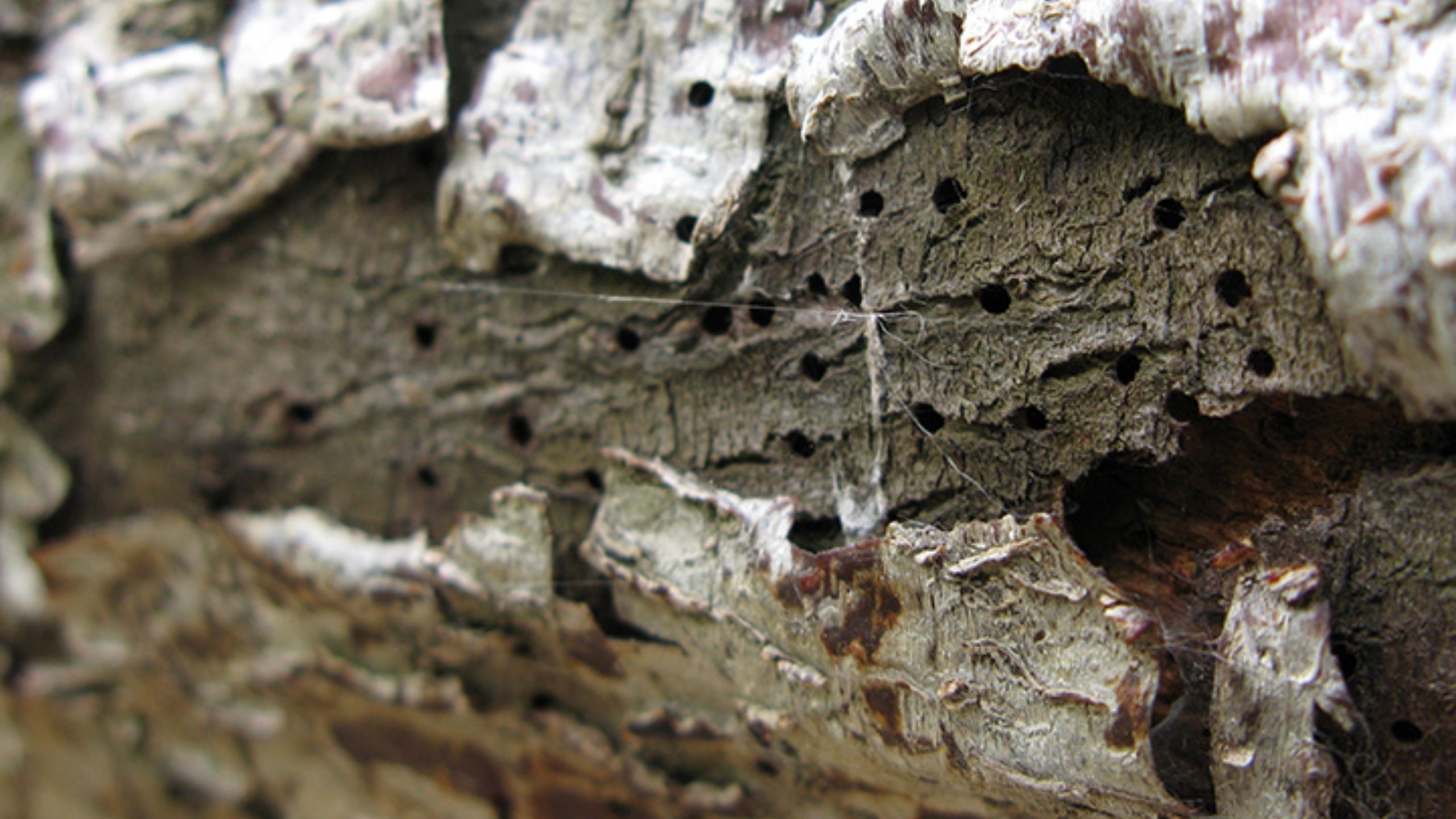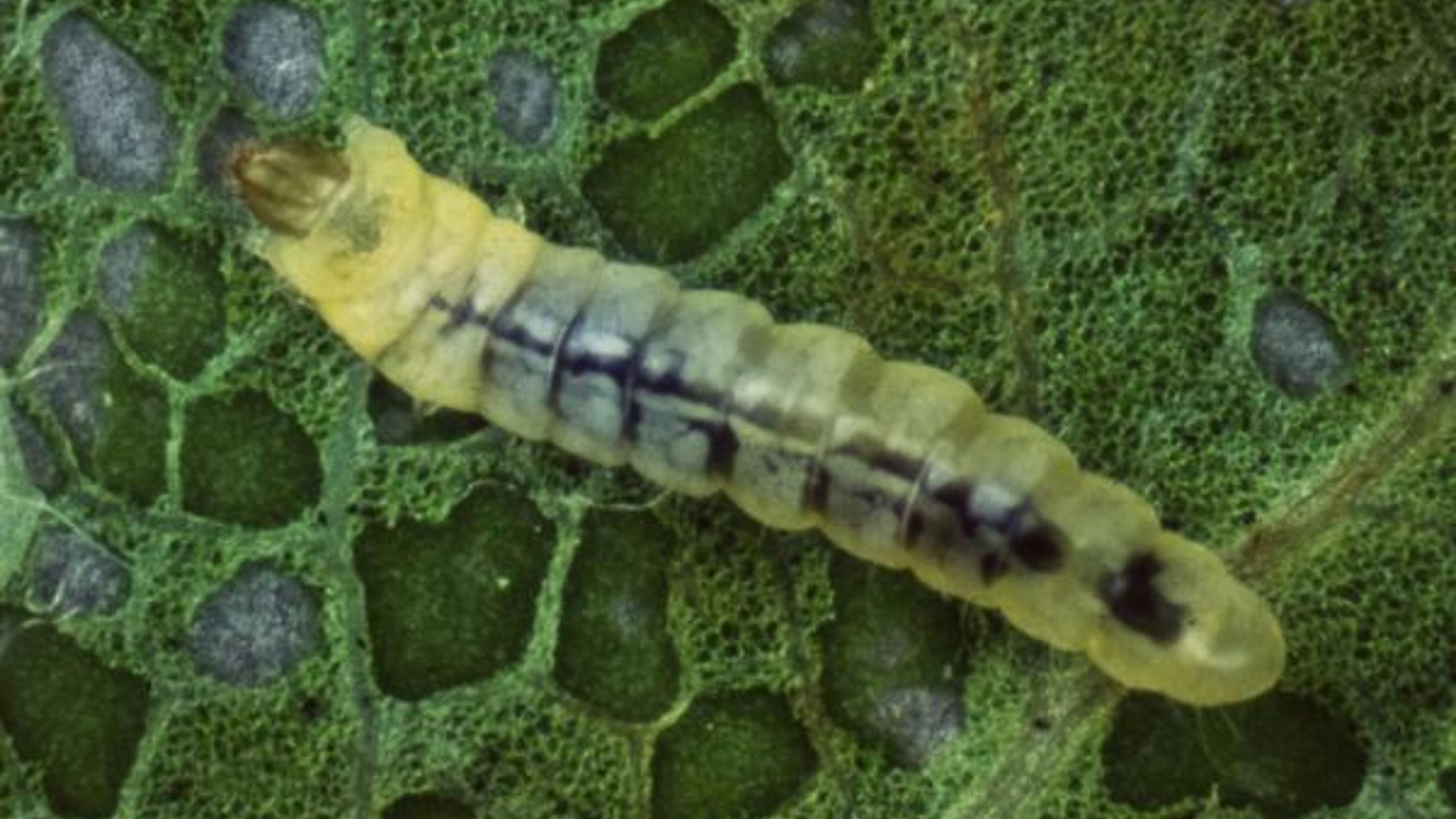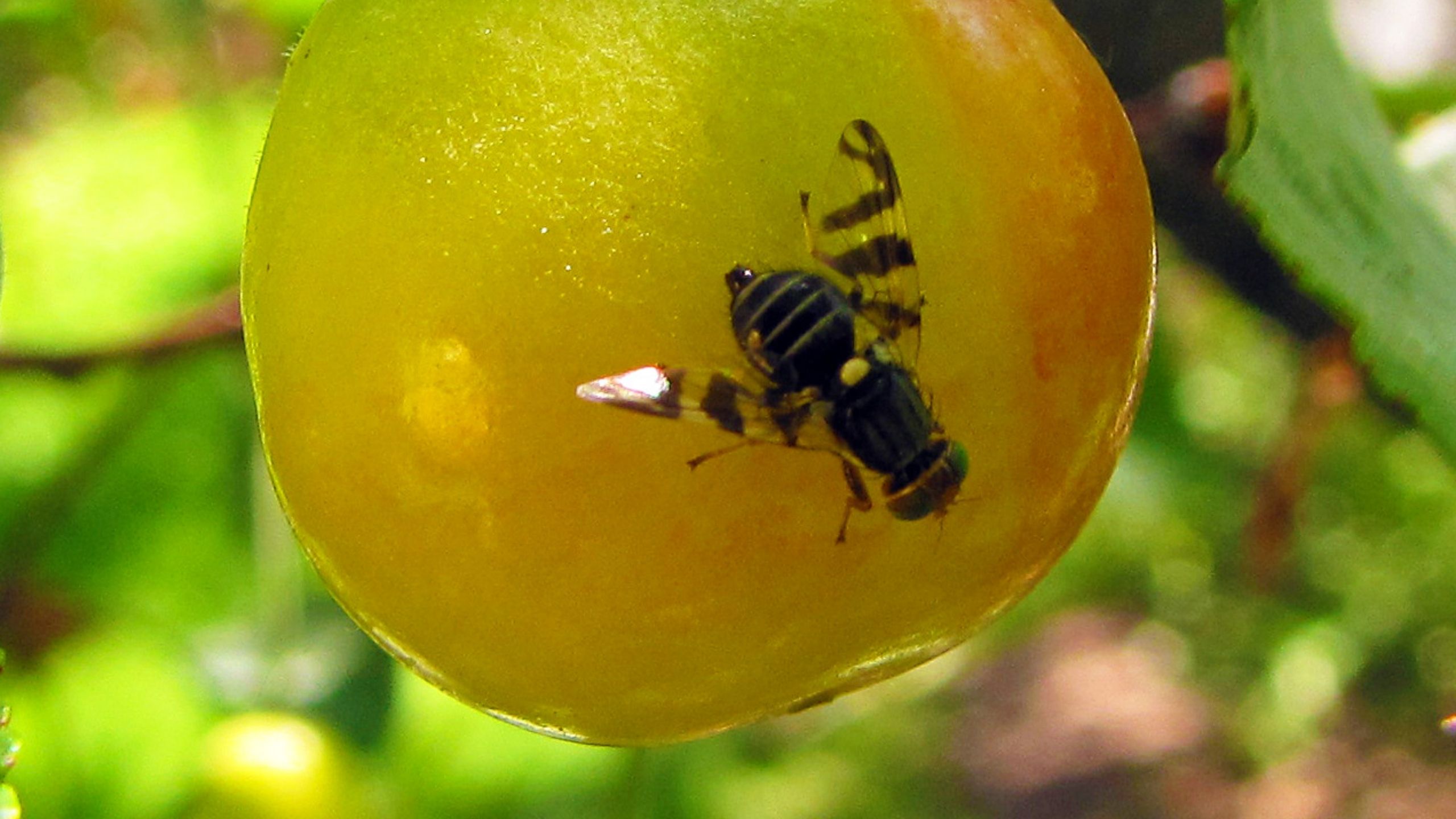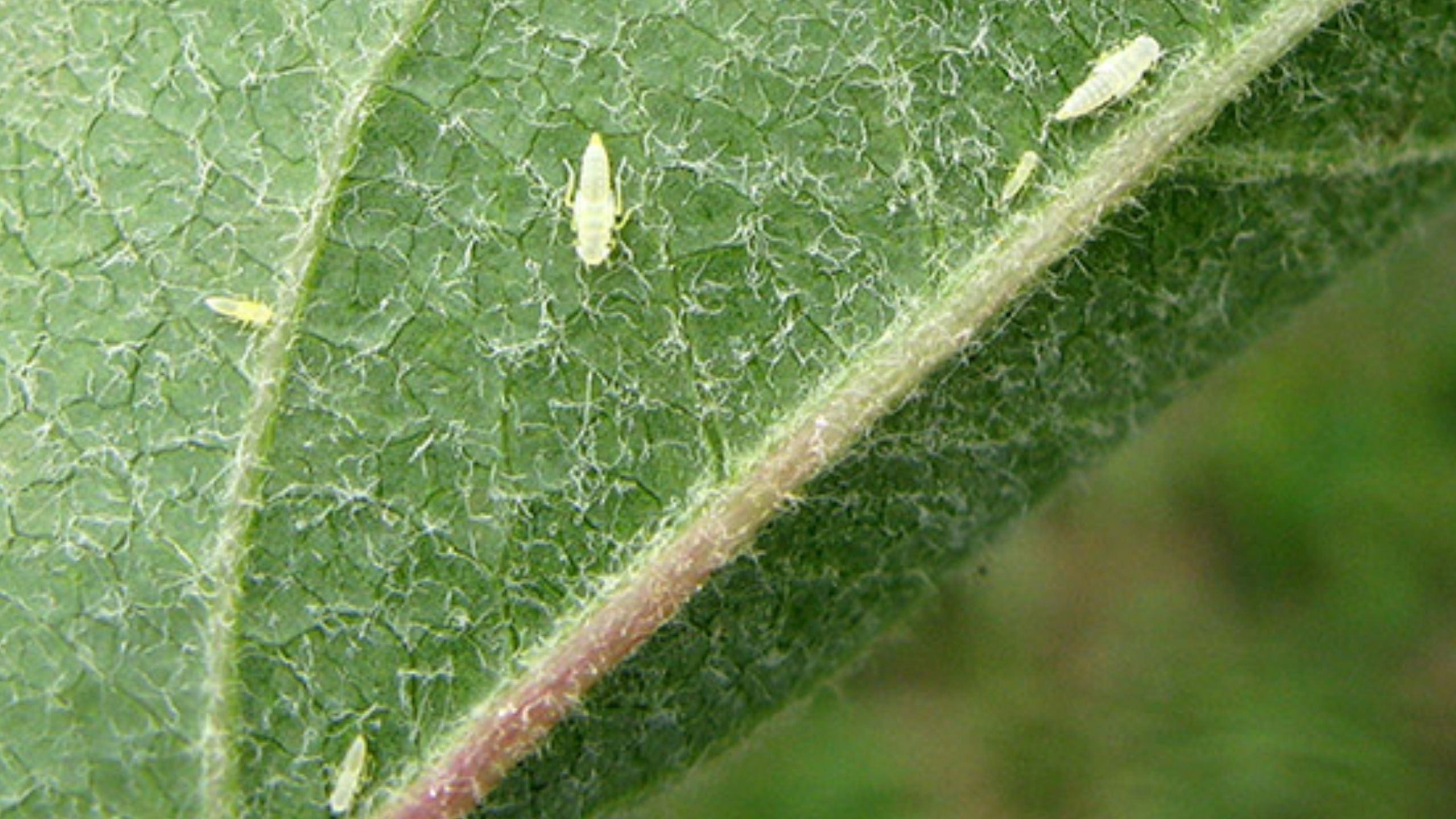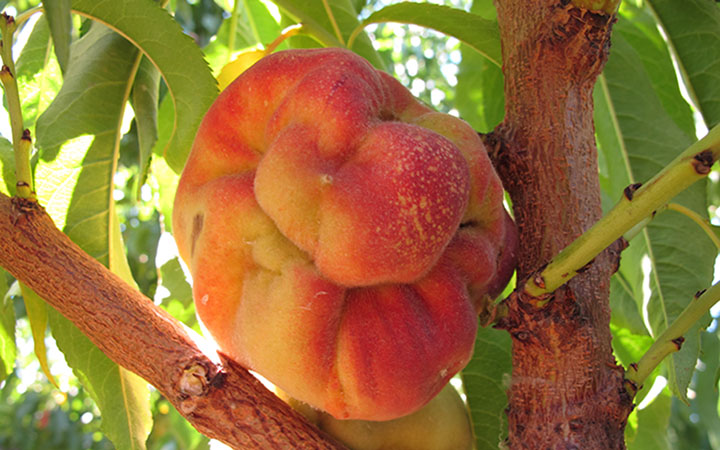Greater Peachtree Borer
November 2010
Diane Alston, Entomologist (No longer at USU), Marion Murray, IPM Project Leader
Do You Know?

Image courtesy of H. C. Ellis, University of Georgia (www.ipmimages.org).

- Greater peachtree borer is an important pest of peach, nectarine, apricot, cherry, and plum.
- Adults are clearwing moths and larvae are caterpillars that burrow and feed in the cambium beneath the bark near or just below the soil line.
- Severe larval feeding can girdle and kill trees.
- Mating disruption is an effective control and has been proven in Utah peach orchards as small as 1 acre in size.
- Treatment of lower tree trunks before egg hatch is also effective in preventing injury.
The greater peachtree borer (Order Lepidoptera, Family Sesiidae) is native to North America where wild cherries and plums are its native hosts. It is a sporadic pest in Utah stone fruit orchards, but if left unmanaged it can be severe enough to cause tree loss. The adults are clearwing moths (Fig. 1). The larvae are pinkish-white caterpillars that bore into the trunks where they feed just under the bark in the cambial tissue (Fig. 2). There is one generation per year, but some larvae may require 2 years to complete development (Fig. 3).
Extensive larval feeding can girdle and kill trees. The larvae primarily attack tree trunks just at or below the soil line (Fig. 4), but may enter trunks up to 12 inches above the ground. Other tree problems that are confused with peachtree borer injury include winter freeze and mechanical injury, and infection by canker-causing fungi such as Cytospora. All of these problems can cause copious sap or gum to exude from holes or cracks in the bark. Key symptoms of peachtree borer infestation are the presence of sawdust and frass mixed with the gummy exudate near the base of the trunk (Fig. 5).
Prevention is the most effective approach to management. Pheromone-based mating disruption and trunk sprays with synthetic insecticides are the primary management tactics. Adult peachtree borers become active in mid to late June in northern Utah (Fig. 3) and trunks should be protected from tunneling larvae beginning the first week of July (3-4 weeks earlier in southern Utah) through late August to early September.
Hosts
- peach, nectarine, apricot, plum, prune, cherry, chokecherry
Life History

Adult – Monitoring Stage
- Color and Appearance: Similar in appearance to wasps with a metallic-blue body and clear wings; however, the female’s forewings are covered with blue scales (Fig. 1). The female has a distinct orange band on the abdomen (Fig. 1); the male has three or four narrow, yellow-white abdominal stripes (Fig. 8).
- Size: Female is about 1 inch long, and male is slightly smaller, with a narrower abdomen.
- When: Moths begin flying in early summer, approximately mid June through early September in northern Utah (Fig. 3) and 3-4 weeks earlier in southern Utah; active during the day, especially between 10 a.m. and 2 p.m.
- Mating occurs immediately after emergence; females can lay eggs within 30 minutes of mating and each female can lay 200-1200 eggs over her 6-7 day life-span; the majority of eggs are laid in days 1-3.
Egg
- Size and Shape: Approximately 0.03 inch long, oval, and hard.
- Color: Reddish brown.
- Where: Female lays eggs on the lower tree trunk under bark scales, on rough bark, or on nearby soil.
- Hatch occurs in 7-10 days.
Larva – Damaging Stage
- Size and Color: Newly hatched larva is approx. 0.06 inch long; fully grown larva is up to 1.25 inches long; pinkish-white with a brown head (Fig. 2).
- Where: Larva bores through the bark immediately upon hatching and feeds on inner bark and cambium of the tree, forming galleries.
- Feeds under the bark all summer, and moves down to the base of the tree to overwinter.
- Resumes feeding in the spring when soil temperature reaches 50º F; causes the most damage at this time; pupates in May to August.
Larva – Overwintering Stage

- Size and Color: Can overwinter as 1st to 4th instars; larva size depends on what stage it is in when overwintering begins; pinkish-white with brown head.
- Where: Overwinters under the bark at the base of the tree, usually below ground level (Fig. 4).
Pupa
- Size and Color: 0.75 inch long; light brown; held within a cocoon made of silk, gum, and chewed wood fragments.
- Where: Pupate in the top layer of soil, within a few inches of the host tree, or in the tree near the bark surface.
- When: In the late spring through summer.
- 2 to 4 week development period depending on temperature; soil moisture encourages emergence.
- Pupal skin is left at the base of the tree or in the soil after the adults emerge (Fig. 4).
Host Injury
Greater peachtree borer larvae attack only the lower 12 inches of the host trunk, and usually enter at or just below ground level. Larvae will occasionally feed in larger roots near the soil surface. Larvae tunnel between the inner bark and sapwood in the cambium, and can girdle and kill young trees in one season. Older trees may withstand the damage, but will be predisposed to attack by other insects and diseases, and can be killed after several years of infestation.
Visual symptoms include loose, dead bark and masses of gummy sap mixed with frass exuding from entry and exit holes (Fig. 5). Leaves on a portion of the tree may turn yellow and wilt, and the tree canopy will eventually die back. Similar-looking gummy deposits on the upper trunk or limbs are likely caused by winter or mechanical injury or fungal pathogens, and do not indicate infestation by peachtree borer. The presence of peachtree borer can be confirmed by the skins of pupae left attached to the bark of the lower trunk or in the soil near the trunk base, or
by a larva and/or larval tunnel under the bark (Fig. 6).

Monitoring and Time Control



Look for injury symptoms when pruning trees in the spring and early summer. If symptoms are found, a more intensive control program is needed. Determine the timing of first adult emergence with pheromone traps (Fig. 7). Monitoring adults with traps throughout the summer in stone fruit orchards will provide information on the occurrence and severity of the insect.
Trap Placement and Maintenance
- Delta or wing style pheromone traps can be used to monitor adults (Fig. 7).
- The greater peachtree borer pheromone lure contains a synthetic mimic of the natural sex attractant released by females to attract males for mating. Only male moths are attracted to the pheromone (Fig. 8).
- Place traps with lures by mid June in northern Utah (3-4 weeks earlier in southern Utah) or follow degreeday (DD) model guidelines of 400-500 DD since March 1 to place traps. First moths are expected by 600 DD in high population areas and 950 DD in low population areas [lower and upper thresholds for development are 50ºF and 88ºF, respectively; single sine curve with a vertical cut-off (see http://climate. usurf.usu.edu/pest.php for DD information)].
Manegement
Protection of host trees from peachtree borer is the most critical during the first 3 to 5 years after planting. There are few registered insecticides with adequate longevity to protect trunks from egg-laying and hatching larvae. Mating disruption is the recommended control for commercial stone fruit orchards. For orchards less than 1 acre, or for home yard trees, preventive trunk sprays is the primary control.
Mating Disruption

Mating disruption (MD) of greater peachtree borer has been proven effective in Utah, even in peach orchards as small as 1 acre.
- Place pheromone dispensers throughout the orchard immediately after the first trap catch or at 600-950 DD. Secure dispensers on lateral branches, above the mid-point of trees. Apply a minimum of 100 dispensers per acre. (Example of a brand: Isomate®-P, Pacific Biocontrol Corp., approximately $40/acre.)
- Only a single application is required as dispensers may release pheromone up to 120 days.
- Effective MD should completely shut-down moth catch in pheromone traps (Fig. 9).
Insecticides
Only a small number of products are registered for peachtree borer that have adequate longevity to protect trees from egg-laying and tunneling larvae for several weeks to a month. Apply the first application immediately after first trap catch, at 600-950 DD, or no later than the first week of July in northern Utah (3-4 weeks earlier in southern Utah), and repeat applications based on product label guidelines. Follow the required pre-harvest interval (time between last application and allowed harvest of fruit) of insecticide products. Apply insecticides as a bark drench at a rate of 1/2 to 1 gallon of spray mix per tree. Thoroughly cover the lower 12 inches of trunk and soak the ground at the base of the tree. Do not allow the sprays to contact fruit. Remove prunings, debris, or weeds at the base of trees to avoid interference with spray coverage.
- carbaryl (Sevin)H
- chlorpyrifos (Lorsban)
- esfenralerate (AsanaR)
- lambda-cyhalothrin (WarriorR, LambdaR)
- lambda-cyhalothrin + chlorantraniliprole (Volium XpressR)
- permethrin (AmbushR, PounceR, many other brandsH)
HInsecticide products that may also be available for use on home fruit trees.
RRestricted use products.
NOTE: All brand names are registered trademarks. Examples of brands may not be all-inclusive, but are meant to provide examples of effective insecticides registered on peach in Utah. The availability of insecticides changes rapidly. Always check the label for registered uses, application and safety information, and protection and pre-harvest intervals.
Cultural and Mechanical Controls
- Select appropriate fruit tree species for the site to avoid stressed and unhealthy trees.
- Use good cultural practices (i.e., fertilization, irrigation, etc.) to maintain trees in a healthy and vigorous state.
- Paint trunks with a 1:1 dilution of white latex paint to water, or apply white tree wraps in the winter to prevent bark damage from sunscald.
- Do not leave wraps on trees during the summer. This has been shown to increase borer attack.
- Avoid mechanical and rodent-caused injuries to trunks.
- Certain rootstocks have been found to result in fewer emerging adults. ‘Siberian C’ peach rootstock had 40% fewer emerging adults than ‘Lovell’ rootstock in one study.
- Larvae inside trunks can be killed by inserting a wire into entry holes. Kill larvae in the late summer and fall before they spend the winter and inflict their most extensive feeding damage the following spring.
- Keep the base of trees free of vegetation. Heat and dryness reduce the survival of eggs and larvae.
Biological Control
Several species of parasitic wasps have been reared from larvae or pupae of peachtree borer. We do not have information on occurrence of parasitoids attacking peachtree borer in Utah. Parasitoids identified from elsewhere include wasps from the following families: Braconidae, Eulopidae, Ichneumonidae, and Scelonidae. The entomopathogenic nematodes, Steinernema carpocapsae and Heterorhabditis bacteriophora, have been shown to control borer larvae if sprayed on frasssurrounded bark cracks during the summer. This method helps with killing borer larvae that have already infested the tree, so is not a preventive control.



